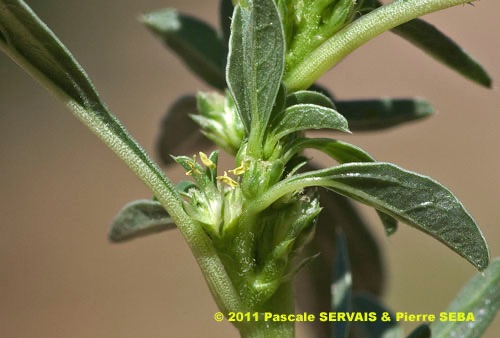
Amaranthus blitoides S.Watson
Fam. : Amaranthaceae
© Pascale SERVAIS & Pierre SEBA, 2018. Tilo Botanica: Flore de Tilos et du Dodécanèse / Flora of Tilos and of the Dodecanese
English translation by Brenda Bradbury, Howard Bradbury and Stéphane Léonard
Plante herbacée, monoïque, à tiges rampantes, étalées sur le sol, très ramifiées, cylindriques, glabres, feuillées jusqu’au sommet.
Feuilles alternes, simples, entières, elliptiques à obovales, parfois spatulées, pétiolées, glabres, pas ou à peine ondulées, de 15 à 20 mm de long, souvent rougeâtres, à marge et nervures de la face inférieure blanchâtres.
Fleurs à symétrie radiaire, verdâtres, d’environ 2 mm de diamètre, réunies en glomérules ou en panicules de 5 à 10 mm de long. 4 ou 5 tépales membraneux, libres, unis, allongés, ovales, aigus, inégaux en longueur et en largeur. Ovaire supère.
Fruits, capsules légèrement sphériques, assez lisses et déhiscentes, de 2 mm de diamètre, à graines noires, luisantes, de plus de 1,2 mm.
___________________________
Plant herbaceous, monoecious. Stems trailing, spread out over the ground, very branched, cylindrical, glabrous, leafy up to the top.
Leaves alternate, simple, entire, elliptic to obovate, sometimes spatulate, petiolate, glabrous, not or scarcely wavy, from 15 to 20 mm long, often reddish, with edges and veins of the lower surface whitish.
Flowers radially symmetrical, greenish, approximately 2 mm in diameter, joined together in glomeruli or panicles from 5 to 10 mm long. 4 or 5 tepals membranous, free, self-coloured, lengthened, ovate, acute, unequal in length and across. Ovary superior.
Fruits, slightly spherical, rather smooth and dehiscent capsules, 2 mm in diameter, with black, shiny seeds, more than 1.2 mm.
Descripteurs / Identifying features
1
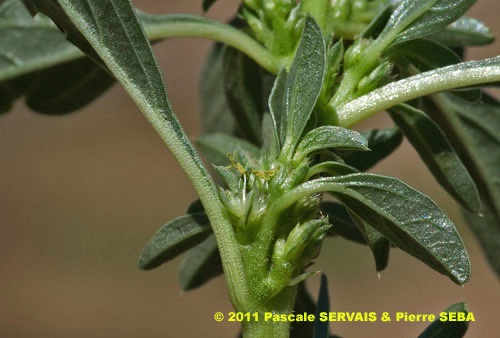
2
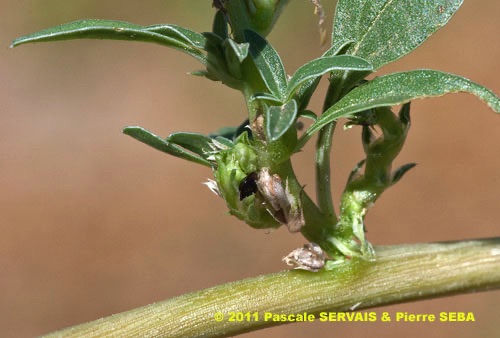
3
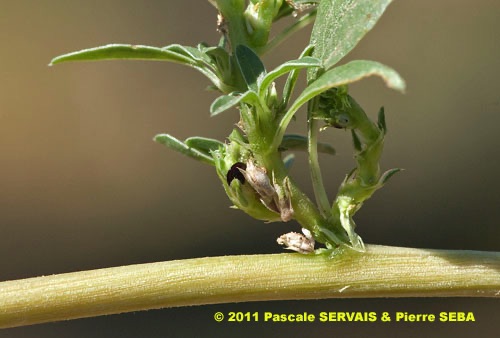
4
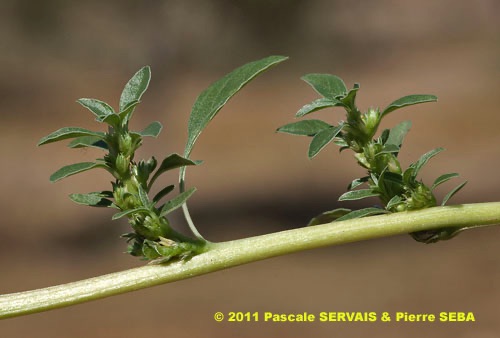
5
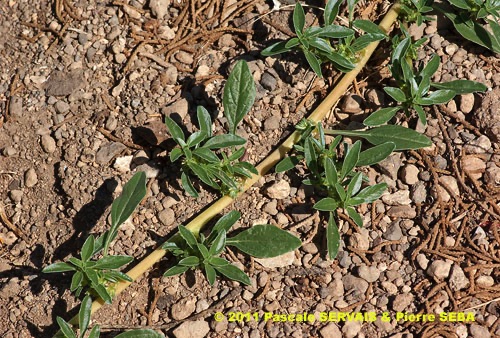
6
Étymologie / Etymology :
Amaranthus : emprunt du latin amarantus, -i (nom), forme latinisée du
grec ancien ἀμάραντος, -ος, -ον (adj.) [ < α- (α privatif) = sans
+ μαραίνω (verbe) = flétrir, se flétrir ] = qui ne se flétrit pas, immortel.
La forme employée en botanique (amaranthus avec th) n’a aucune
justification étymologique!
Blitoides : emprunt du grec ancien βλίτον, -ου (nom) = la blette,
plante fade utilisée autrefois en salade + -οειδης (suffixe) = -oïde,
qui ressemble à [ < εἶδος, -ους (nom) = l’apparence, l’aspect ]
= qui a l’apparence de la blette, qui ressemble à la blette.
Amaranthus : borrowed from Latin amarantus, -i (noun), Latinized form
of the Classical Greek ἀμάραντος, -ος, -ον (adj) [ < α- (α privative)
= without + μαραίνω (verb) = to wither ] = that does not wither,
everlasting flower. The form used in botany (amaranthus with th) has
no etymological justification!
Blitoides : borrowed from Classical Greek βλίτον, -ου (noun)
= chard, a tastless vegetable formerly used + -οειδης (suffix)
= -oid, resembling [ < εἶδος, -ους (noun) = appearance, aspect ]
= which has the appearance of chard, resembling chard.
Synonymes / Synonyms :
Amaranthus aragonensis Sennen
Amaranthus blitoides var. crassior Jeps.
Amaranthus turolensis Sennen
Galliaria blitoides (S.Watson) Nieuwl.
Noms vernaculaires / Common names :
Noms français / French names :
Amarante à feuilles marginées — Amarante fausse blette —
Amarante fausse blite — Fausse amarante.
Noms grecs / Greek names :
Βλήτο πλαγιαστό — Πλαγιαστό βλήτο.
Noms anglais / English names :
Mat amaranth — Prostrate amaranth — Prostrate pigweed.
Noms allemands / German names :
Niederliegender Amarant — Westamerikanischer Amarant —
Westamerikanischer Fuchsschwanz.
Noms espagnols / Spanish names :
Amaranto — Bledo — Breo — Hebreo.
Noms italiens / Italian names :
Amaranto a foglie marginate — Amaranto blitoide.
Habitat :
Cultures - Lieux incultes - Sols sableux.
Cultivated places - Waste ground - Sandy soils.
Île / Island :
Tilos.
Hauteur / Height range :
De 10 cm à 30 cm.
From 10 cm to 30 cm.
Floraison / Flowering time :
De juillet à octobre.
From July to October.
Groupe / Classification :
Dicotylédones.
Dicotyledons.
Pérennité / Lifespan :
Annuelle.
Annual.
Description :
Clés dichotomiques et descripteurs distinctifs des 2 espèces / Dichotomous keys and distinctive identifying features of the 2 species
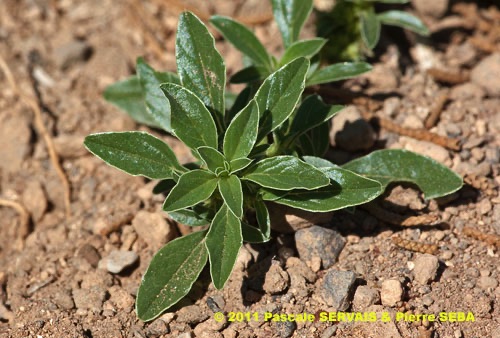
7
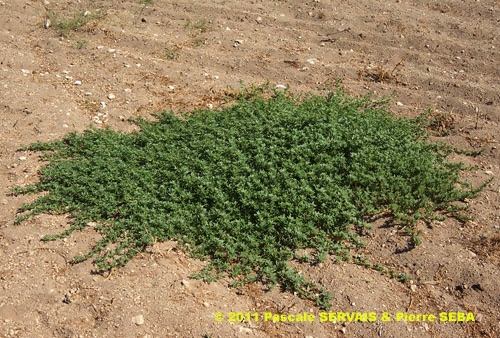
8
Photo 1 :
Localisation / Location : Tilos, Megalochorio, Plaine d’Erystos
Date : 01/10/2011
GPS : Lat. 36,44085° N / Long. 27,34972° E / Alt. 16 m
Type : Photographie numérique / Digital Photograph (10 mégapixels)
Photo 2 :
Localisation / Location : Tilos, Megalochorio, Plaine d’Erystos
Date : 01/10/2011
GPS : Lat. 36,44085° N / Long. 27,34972° E / Alt. 16 m
Type : Photographie numérique / Digital Photograph (10 mégapixels)
Photo 3 :
Localisation / Location : Tilos, Megalochorio, Plaine d’Erystos
Date : 01/10/2011
GPS : Lat. 36,44085° N / Long. 27,34972° E / Alt. 16 m
Type : Photographie numérique / Digital Photograph (10 mégapixels)
Photo 4 :
Localisation / Location : Tilos, Megalochorio, Plaine d’Erystos
Date : 01/10/2011
GPS : Lat. 36,44085° N / Long. 27,34972° E / Alt. 16 m
Type : Photographie numérique / Digital Photograph (10 mégapixels)
Photo 5 :
Localisation / Location : Tilos, Megalochorio, Plaine d’Erystos
Date : 01/10/2011
GPS : Lat. 36,44085° N / Long. 27,34972° E / Alt. 16 m
Type : Photographie numérique / Digital Photograph (10 mégapixels)
Photo 6 :
Localisation / Location : Tilos, Megalochorio, Plaine d’Erystos
Date : 01/10/2011
GPS : Lat. 36,44085° N / Long. 27,34972° E / Alt. 16 m
Type : Photographie numérique / Digital Photograph (10 mégapixels)
Photo 7 :
Localisation / Location : Tilos, Megalochorio, Plaine d’Erystos
Date : 01/10/2011
GPS : Lat. 36,44085° N / Long. 27,34972° E / Alt. 16 m
Type : Photographie numérique / Digital Photograph (10 mégapixels)
Photo 8 :
Localisation / Location : Tilos, Megalochorio, Plaine d’Erystos
Date : 01/10/2011
GPS : Lat. 36,44085° N / Long. 27,34972° E / Alt. 16 m
Type : Photographie numérique / Digital Photograph (10 mégapixels)

Google Maps
Google Maps
Google Maps
Google Maps
Google Maps
Google Maps
Google Maps
Google Maps